
- Memory changes everything. Traditional page-by-page optimization fails when Google tracks 10+ questions in a conversation thread.
- Premium search is here. Google charges for Deep Search and Gemini 2.0 Pro—signaling massive platform investment.
- Conversation replaces keywords. AI Mode users describe problems in natural language, not search terms—making traditional keyword targeting far less effective.
- Structured content wins. AI favors content with clear headings, layered depth, and schema markup it can easily extract and cite in responses.
- The 18-month advantage window. Early adopters face minimal competition while others chase yesterday’s playbook.
Roll over, SEO: Here comes Google AI Mode!
While your SEO guy still peddles keyword density and meta descriptions, there’s a seismic shift in search going on. With Google AI Mode, users aren’t clicking Google links: they’re having conversations with Google’s AI, without ever visiting your website.
The numbers paint the picture: Clickthrough rates (CTR) decreased by 30% in the past 12 months as users increasingly find the answers they need directly within Google’s AI Overviews, rather than clicking through to external sites.
AI Mode is expected to decrease clickthroughs still further.
This isn’t an algorithm change. It’s a fundamental restructuring of how humans find information.
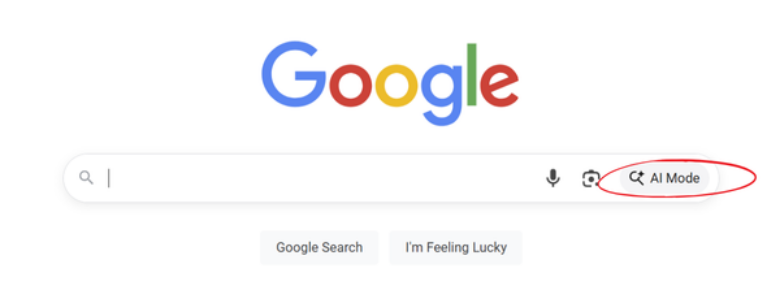
What Is Google AI Mode?
Google AI Mode represents the company’s most significant interface change in Google history. But unlike past updates that tweaked algorithms or adjusted ranking factors, this shift changes the core interaction model.
Instead of returning a list of “website links” that we all know so well, Google AI Mode provides a more conversational, ChatGPT-like experience. The only links are the “featured sources” on the right rail–there are no links down below.
AI Mode is a dedicated conversational interface, where the user never needs to leave Google. Users can discuss, refine, and explore topics through natural dialogue. More importantly, the AI maintains context across the entire session (i.e., it remembers).
(Note: Google AI Mode is currently available as a beta feature, which means you may not have access to it if your workplace uses Google Suite. Try accessing it with your personal Gmail account instead.)
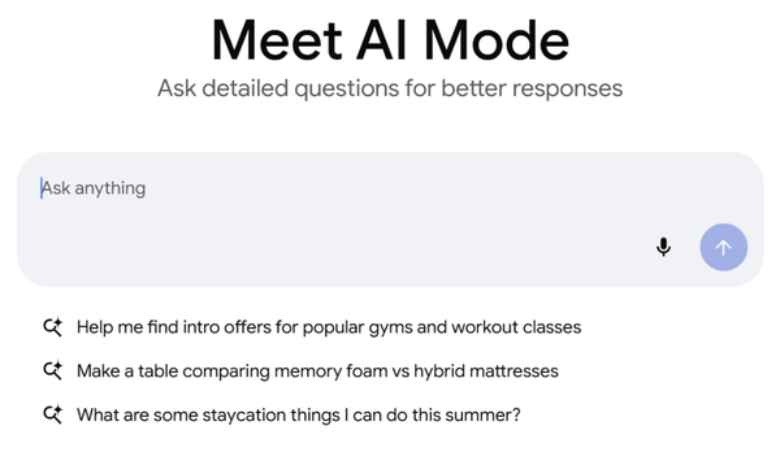
Traditional search session:
- Query: “enterprise CRM software” → Results page A
- New query: “CRM implementation costs” → Results page B
- New query: “Salesforce vs HubSpot” → Results page C
- Each search starts fresh, no connection between queries
AI Mode session:
- “I need to improve our sales tracking”
AI responds with CRM overview
- “We have about 50 salespeople”
AI adjusts recommendations for mid-size teams
- “What about implementation time?”
AI provides specific timelines based on team size
- “Is Salesforce overkill for us?”
AI compares options within established context
The user never typed “CRM,” never mentioned company size in a search box, and never crafted the perfect query. They just explained their problem.
AI Mode vs AI Overview
Many marketers confuse these two Google features—so let’s get them straight.
AI Overview: Enhanced featured snippets appearing in traditional search results. These summarize existing content but don’t engage in dialogue.
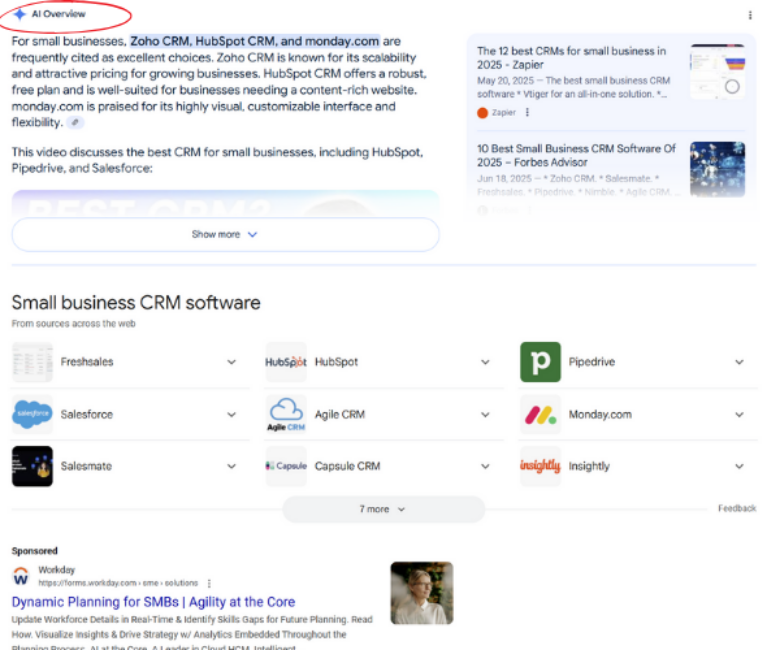
AI Mode: A separate conversational interface accessed through a dedicated tab or direct link. This creates an entirely different user experience focused on dialogue rather than queries.
Notice the chat-like interface. Sources appear as cards on the side, but the conversation takes center stage. Users can ask follow-ups, request clarification, or pivot topics entirely—all while Google maintains the context.
Traditional SEO vs AI Mode
Most SEO strategies assume users arrive via specific keywords. We optimize for “best CRM for small business” and hope to capture that exact search. But AI Mode users don’t think in keywords—they think in problems and conversations.
Consider this real user journey we tracked:
Traditional SEO assumption
- User searches: “small business CRM”
- Lands on optimized page
- Converts or bounces
Actual AI Mode journey
- “Our sales team is losing track of leads”
- “We tried spreadsheets but they’re not working”
- “Maybe we need software?”
- “What do other companies our size use?”
- “How hard is this to set up?”
- “Can it integrate with Gmail?”
The user never used the term “CRM.” They described a problem and explored solutions conversationally. Your perfectly optimized “small business CRM” page never had a chance to appear.
The Authority Algorithm
In AI Mode, Google prioritizes comprehensive authority over keyword optimization. The AI needs to understand topics deeply to maintain coherent conversations. This means it favors sources that demonstrate:
- Topic depth: Complete coverage of subject areas
- Contextual connections: How concepts relate to each other
- Natural language: Conversational explanations over keyword-stuffed copy
- Fresh perspectives: Regular updates showing ongoing expertise
Optimizing Content for AI Mode
To succeed with Google’s AI Mode, your content needs more than a fresh coat of SEO paint. Effective optimization means structuring content specifically for conversational journeys, not isolated keyword searches.
Here’s how to create content that Google’s AI actively selects, prioritizes, and shares in conversational interactions.
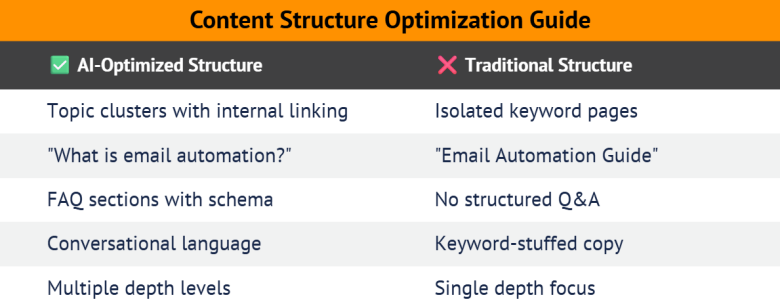
1. Build topic webs, not keyword pages
Stop creating isolated pages for keyword variations. Start building interconnected content ecosystems.
Old approach:
- Page 1: “Email marketing software”
- Page 2: “Email automation tools”
- Page 3: “Marketing automation platforms”
- Page 4: “Email campaign management”
AI Mode approach:
Create a comprehensive email marketing resource center:
- Core guide explaining email marketing strategy
- Technical setup and authentication details
- Design principles and template guidance
- Automation workflow tutorials
- Analytics and optimization frameworks
- Compliance and deliverability guides
Each piece naturally links to others, creating a web of expertise. When Google’s AI encounters questions about email marketing, it recognizes your site as a complete authority rather than a collection of keyword pages.
2. Structure for AI extraction
Google’s AI analyzes content passage by passage, looking for clear, extractable information. Structure your content to make this process seamless:
Question-based headings: Transform headings into natural questions:
- DON’T say: “CRM benefits”
- DO say: “What are the main benefits of using a CRM?”
Progressive depth structure:
- Quick answer (first paragraph): Direct response to the heading question
- Context (second paragraph): Why this matters for the reader
- Details (bullets or subsections): Specific implementation information
- Advanced considerations (final section): Edge cases and nuances
Rich FAQ integration: FAQs naturally align with conversational queries. But don’t just list questions—provide comprehensive answers that could stand alone in an AI conversation. Apply FAQ schema markup to explicitly signal this content type to Google.
3. Create conversation-worthy content
Because AI Mode can answer basic questions directly, your content needs to offer value beyond simple information.
We asked Google’s Gemini which content types are preferred by AI Mode, and this was the response:
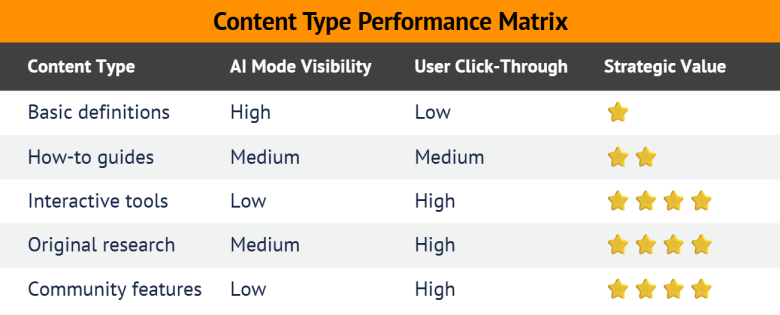
4. Optimize for memory (context persistence)
Unlike traditional searches that reset with each query, AI Mode remembers your questions within a conversation. Your content should anticipate and support these conversational journeys.
Example: SaaS Comparison Content
Traditional approach: “Salesforce vs HubSpot: Complete Comparison”
AI Mode approach: Create content that supports a journey:
- Start with problem identification (“Why sales teams struggle with lead tracking”)
- Progress to solution categories (“Types of sales tracking systems”)
- Dive into specific comparisons (“How enterprise CRMs differ from small business tools”)
- Address implementation concerns (“What to expect during CRM setup”)
- Cover ongoing success (“Measuring CRM ROI after 6 months”)
Each piece connects naturally, supporting users wherever they enter the conversation.
How to Measure AI Mode Success
As AI Mode transforms user interactions, keyword rankings and click-through rates no longer tell the whole story. To accurately measure success, marketers must track how effectively their content engages users within ongoing conversations.
These metrics will help you understand your content’s true impact in Google’s new conversational AI mode:
AI visibility score
Monitor how often your content appears in AI Mode responses:
- Set up branded query tracking in AI Mode
- Test common problem-based queries in your industry
- Track appearance frequency and context quality
Conversation depth metrics
Measure whether your content supports extended conversations:
- Average questions per session landing on your content
- Topic coverage breadth within AI responses
- Cross-content references within single conversations
Authority indicators
Track signals of topical authority:
- Frequency of citation in AI responses
- Comprehensiveness of excerpts used
- Connection density between your content pieces referenced
Impact on ROI
While Google does not release figures of this type, the chart below is in line with general expert consensus as of this writing.
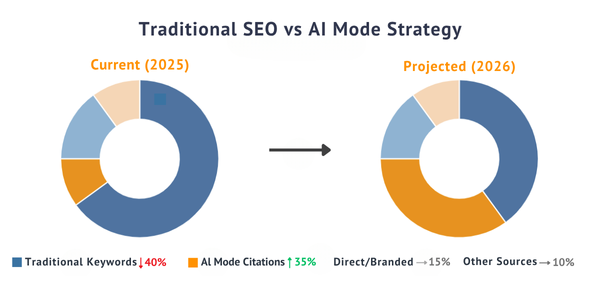
Industry experts project that the next 12 months will bring a seismic shift in how audiences find your content. Traditional keyword search is expected to drop dramatically as users embrace conversational AI.
Meanwhile, zero-click searches now constitute nearly 60% of U.S. Google searches—meaning a majority of queries result in users getting their answer without clicking through to a website.
AI Mode will only increase that percentage, so a large portion of your organic visibility could soon depend on whether Google’s AI references your content within conversational search interactions.
This shift isn’t theoretical—it’s already underway. Brands optimized for both traditional search and conversational positioning will secure maximum visibility, while marketers who cling solely to keyword tactics will watch competitors capture traffic they’ve overlooked.
How Will Google Make Money from AI Mode?
As conversational search gains momentum, marketers need to understand how Google’s monetization strategy might reshape visibility and costs.
Here’s how Google plans to capitalize on its conversational search revolution—and what that means for your marketing strategy.
Google is already charging for premium AI features:
- Basic AI Mode: Free (for now)
- Gemini Advanced: $30/month for longer conversations
- Deep Search: Extra fee for complex research queries
- Gemini 2.0 Pro: Premium pricing for advanced features
In the near future, expect to see:
- Sponsored answers in AI conversations (like ads in search results)
- Business subscriptions for companies to access AI Mode data
- Pay-to-play visibility where brands pay to be recommended by the AI
When this happens: While Google hasn’t announced exact dates, the pattern is clear. Premium tiers launched first (already live), sponsored content typically follows within 12-18 months, and enterprise solutions emerge as the platform matures.
We saw this same progression with Google Ads, YouTube, and Gmail.
Bottom line: Free AI Mode won’t last forever. Smart marketers are building their presence now, before it becomes pay-to-play.
The AI Mode Opportunity Timeline
The window for competitive advantage is narrowing fast. Right now, most brands are still caught off-guard by AI Mode’s implications. They’re still optimizing for traditional SEO while search behavior fundamentally shifts beneath them.
This creates a massive opportunity for marketers who move quickly. Early adopters are currently experimenting with minimal competition, testing what works, and building expertise while their competitors remain focused on traditional SEO metrics.
But this advantage won’t last. Based on current adoption patterns and Google’s rollout strategy, the competitive landscape will shift dramatically over the next 18 months.
According to Gemini, here’s what marketers can expect:
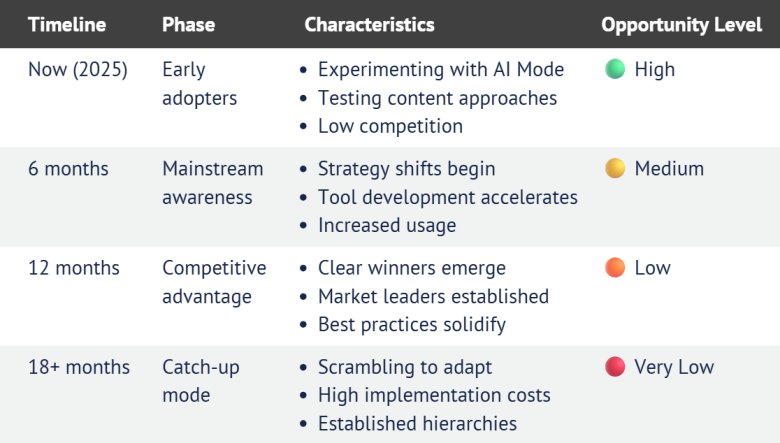
The timeline makes it clear: The shift to conversational search isn’t a trend—it’s the new reality. Google’s AI Mode represents the biggest change in how people find information since the search engine was invented.
The brands that recognize this shift early and adapt their content strategy accordingly will dominate the next decade of digital marketing.
The choice is simple: Optimize for the future now, or scramble to catch up later when the competition is fierce and the best opportunities are gone.
Still have questions? Check out our FAQ below!
Marketer Takeaways
- Memory changes everything. Traditional page-by-page optimization fails when Google tracks 10+ questions in a conversation thread.
- Expect traffic reductions. Top-of-funnel traffic may decrease by 20-40% as AI Mode answers basic questions directly.
- Interactive content is your moat. Calculators, assessments, and tools drive much higher engagement when AI can only summarize.
- The 18-month window. Based on adoption curves, brands have until mid-2026 before AI Mode optimization becomes table stakes.
- Test with Deep Search first. Google’s premium tier reveals which content the AI considers most valuable. Use it as your optimization roadmap.
Media Shower’s AI-first marketing platform was built for this moment. Click here for a free trial.
Frequently Asked Questions About Google’s AI Mode
What is Google’s AI Mode?
Google’s AI Mode is a conversational search experience that delivers context-aware answers. It allows users to engage naturally and refine their queries without starting over.
How does AI Mode differ from traditional search?
Traditional search shows a static list of results based on single keyword queries. AI Mode understands natural language, maintains context, and builds on prior questions to deliver more relevant answers.
What features does AI Mode include?
AI Mode supports deep research, real-time reasoning, coding help, math problem-solving, and long-form assistance. It functions more like a digital assistant than a typical search engine.
What’s the difference between AI Mode and ChatGPT for search?
AI Mode is built into Google Search and pulls from live web content while maintaining conversation history. ChatGPT relies on training data and only accesses the web in specific browsing-enabled modes.
Is AI Mode available to everyone?
AI Mode is rolling out in phases. Core features are free for most users, while advanced capabilities are available through paid Gemini plans.
Will AI Mode reduce traditional website traffic?
Yes, because users often get answers directly in the interface without clicking through. however, the traffic that does come through tends to be more qualified and conversion-ready.
Should I stop optimizing for traditional search?
No—traditional search still drives traffic. The smart approach is to optimize for both by creating content that works in search results and feeds conversational AI.
Is traditional SEO still relevant?
Yes—but it’s not enough on its own. You still need strong fundamentals, but AI Mode favors comprehensive, authoritative content that addresses full user journeys.
Are keywords still important?
Yes, but they work differently. Instead of stuffing keywords, focus on using them naturally within well-structured, topic-rich content.
How can brands optimize content for AI Mode?
Focus on in-depth, structured content written in natural language. Use question-based headings, internal topic links, and schema markup to make your content easier for AI to cite.
How long should my content be for AI Mode optimization?
Length matters less than structure and depth. Prioritize comprehensive coverage at multiple levels over hitting a specific word count.
How do I measure SEO success in AI Mode?
Move beyond rankings and clicks. Track how often your content appears in AI responses, how well it supports extended conversations, and how frequently it’s cited across related topics.
How do I know if my content is being used by AI Mode?
Google doesn’t provide detailed AI Mode analytics yet. You can monitor indirect signals like brand mentions, referral traffic shifts, and by testing AI Mode with your content topics.
Can I track AI Mode performance like traditional SEO?
Current tools don’t offer specific AI Mode tracking. Focus on traffic patterns, branded search volume, and direct engagement indicators to spot impact.


